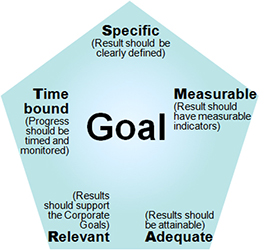Smartification Model
The development of goals is for everybody a show of strength. In the problem/ goal specification a procedure was introduced to find goals (August 2010). Ideally the number of goals should not exceed 5plusminus2. Depending on the goal definition there might be more or less room for interpretation. Smartification provides a structure that enables to round up the concretion of goals in a way that allows all participants to better understand the goals.
Smartification provides five criteria for the complete description of goals: Goals should be specific, measurable, adequate, relevant and time bound.

A goal can be a location or a condition that should be reached within short-term but at least within mid-term. Challenging goals produce better results than mediocre, easy to reach goals. Goals are derived from the strategy that provides a long-term direction. In this process goals should harmonize with each other to prevent counterproductive effects. Smartification sets the stage for an effective goal management by ensuring that the most relevant aspects are defined. Below the criteria are described shortly:
S pecific
A goal is described specifically, when it is easy to understand, free from ambiguity and provides a concrete description of the result. An example is a 10% sales increase by December 31 the current year.
M easurable
A goal is described measurably, when the target condition can be measured with concrete key figures and be interpreted unambiguously. The indicators might be amount, cost, time, quality criteria but also satisfaction indices (e.g. of customers, employees, suppliers). An example is the amount of products sold.
A dequate
A goal is adequate, if it is not too difficult or too easy to be reached. Too high requirements perish the people in charge, demotivate and often do not lead to the desired result. Too low requirements challenge the people in charge not enough, leads to sloppiness and often to not accomplish the desired results. An example for an adequate goal is the definition of the scope – e.g. evaluate the local areas.
R elevant
A goal is relevant, if it fits to the strategy, i.e. supports the vision, fits to the mission and can be related to a strategic goal. Additionally it should be made clear the difference that makes the difference. Examples are concrete growth targets like 10% more direct customers.
T ime bound
A goal is time bound, if it has a schedule with milestones. Thereby milestones are sub-goals on the way to the actual goal. They provide early indication of deviations. An example is the regular reporting of the number of items in the monthly report.
